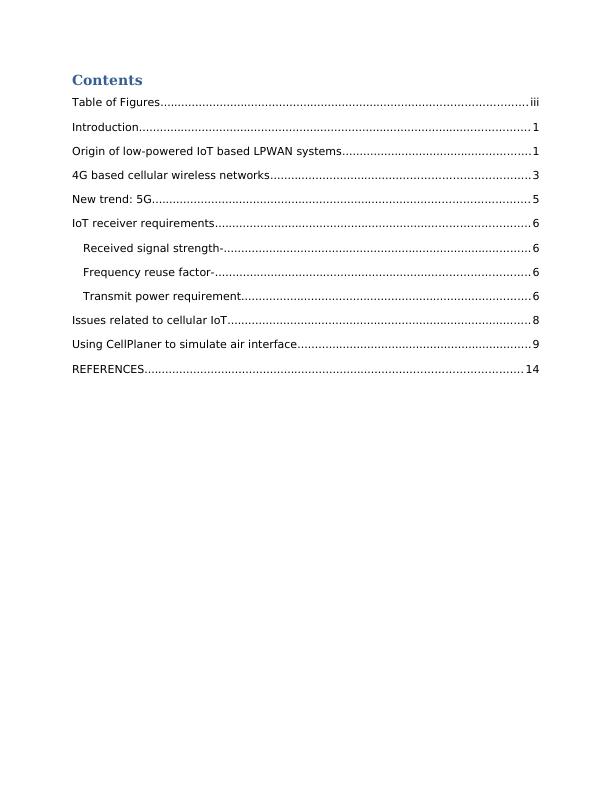Low-Powered IoT Based LPWAN Systems and Cellular Networks
Added on 2022-11-22
17 Pages4107 Words142 Views
COURSE TITLE: Telecommunications
Course Code:
Task: Group Assignment
SUBMITTED BY
SUBMITTED TO
DATE: September 22, 2019
Course Code:
Task: Group Assignment
SUBMITTED BY
SUBMITTED TO
DATE: September 22, 2019

Contents
Table of Figures......................................................................................................... iii
Introduction................................................................................................................ 1
Origin of low-powered IoT based LPWAN systems......................................................1
4G based cellular wireless networks..........................................................................3
New trend: 5G............................................................................................................ 5
IoT receiver requirements.......................................................................................... 6
Received signal strength-........................................................................................ 6
Frequency reuse factor-.......................................................................................... 6
Transmit power requirement...................................................................................6
Issues related to cellular IoT....................................................................................... 8
Using CellPlaner to simulate air interface...................................................................9
REFERENCES............................................................................................................ 14
Table of Figures......................................................................................................... iii
Introduction................................................................................................................ 1
Origin of low-powered IoT based LPWAN systems......................................................1
4G based cellular wireless networks..........................................................................3
New trend: 5G............................................................................................................ 5
IoT receiver requirements.......................................................................................... 6
Received signal strength-........................................................................................ 6
Frequency reuse factor-.......................................................................................... 6
Transmit power requirement...................................................................................6
Issues related to cellular IoT....................................................................................... 8
Using CellPlaner to simulate air interface...................................................................9
REFERENCES............................................................................................................ 14

Table of Figures
Figure 1: LPWA Cellular IoT........................................................................................ 4
Figure 2: Smart City................................................................................................... 8
Figure 3: CellPlaner Simulator.................................................................................... 9
Figure 4: Smart city Position..................................................................................... 10
Figure 5: Simulate Smart City................................................................................... 10
Figure 6: Simulation................................................................................................. 11
Figure 1: LPWA Cellular IoT........................................................................................ 4
Figure 2: Smart City................................................................................................... 8
Figure 3: CellPlaner Simulator.................................................................................... 9
Figure 4: Smart city Position..................................................................................... 10
Figure 5: Simulate Smart City................................................................................... 10
Figure 6: Simulation................................................................................................. 11

1
Key Terms: Cellular Networks, Cellular IoT, Internet of Things IoT, 5G, 4G, Low Power Wide
Area Networks LPWAN
Introduction
Cellular networks are wireless networks in which the last communication link is wireless i.e.
transmission of information or power happens without any physical connection between the
communicating node. It is distributed over wide geographical area divided into cells. Every cell
in the geographical area is served by one transmitter or a base station. The base station provides
geographical network coverage through which data in the form of voice, audio or visual is
transmitted. Cellular IoT relies on the existing cellular network infrastructure to enhance
communication amongst IoT devices
Origin of low-powered IoT based LPWAN systems
Low- power wide area network (LPWAN) is a wireless telecommunication wide area network
that is designed specifically to permit long rage communications at low bit rate among several
connected devices. These networks uses low power but carries little amounts of data and hence
the name [1]. They operate on a bit rate that is between 0.3 kbps and 50 kbps per channel. This
diverges from wide area network which is designed to connect users or businesses that carries
more data but consumes a lot of power.
These networks are more closely related to alarm to Alarmnet which was built and designed by
ADEMCO Company. It operated in the range of 928 MHz band and was designed was designed
with low data rates. It sent very little amount of data. They were mainly used to monitor alarm
panels. In the 1990’s cellular network realized that they could carry data as well as voice and
this saw the rebirth of 2G networks. As result of, many alarm panel networks migrated to cellular
network in order to take advantage of the widespread coverage and very low hardware costs.
The ARDIS is an all in one platform which was that was designed for data applications. It was
developed and owned by the Motorola Company in the 1980’s. It was a moderately low speed
network that was purposely made for sales automation and, fleet monitoring and tracking, email
and online transactions. It was later absorbed by an American network. User data was picked up
from ARDIS customer based and integrated into later technologies [2].
The most recent technological advancements have led to the re -emergence and wide growth of
LPAN technologies. This has been partly fueled by the increasing demand for internet services
around the around the world. People and businesses are starting to look for low-cost and low –
data devices. They have proven to be vital in many applications such as environmental sensors
that are used to monitor the environment and keep track of such items such as pollution. It has
also been applies in oil and gas monitoring.
Key Terms: Cellular Networks, Cellular IoT, Internet of Things IoT, 5G, 4G, Low Power Wide
Area Networks LPWAN
Introduction
Cellular networks are wireless networks in which the last communication link is wireless i.e.
transmission of information or power happens without any physical connection between the
communicating node. It is distributed over wide geographical area divided into cells. Every cell
in the geographical area is served by one transmitter or a base station. The base station provides
geographical network coverage through which data in the form of voice, audio or visual is
transmitted. Cellular IoT relies on the existing cellular network infrastructure to enhance
communication amongst IoT devices
Origin of low-powered IoT based LPWAN systems
Low- power wide area network (LPWAN) is a wireless telecommunication wide area network
that is designed specifically to permit long rage communications at low bit rate among several
connected devices. These networks uses low power but carries little amounts of data and hence
the name [1]. They operate on a bit rate that is between 0.3 kbps and 50 kbps per channel. This
diverges from wide area network which is designed to connect users or businesses that carries
more data but consumes a lot of power.
These networks are more closely related to alarm to Alarmnet which was built and designed by
ADEMCO Company. It operated in the range of 928 MHz band and was designed was designed
with low data rates. It sent very little amount of data. They were mainly used to monitor alarm
panels. In the 1990’s cellular network realized that they could carry data as well as voice and
this saw the rebirth of 2G networks. As result of, many alarm panel networks migrated to cellular
network in order to take advantage of the widespread coverage and very low hardware costs.
The ARDIS is an all in one platform which was that was designed for data applications. It was
developed and owned by the Motorola Company in the 1980’s. It was a moderately low speed
network that was purposely made for sales automation and, fleet monitoring and tracking, email
and online transactions. It was later absorbed by an American network. User data was picked up
from ARDIS customer based and integrated into later technologies [2].
The most recent technological advancements have led to the re -emergence and wide growth of
LPAN technologies. This has been partly fueled by the increasing demand for internet services
around the around the world. People and businesses are starting to look for low-cost and low –
data devices. They have proven to be vital in many applications such as environmental sensors
that are used to monitor the environment and keep track of such items such as pollution. It has
also been applies in oil and gas monitoring.

End of preview
Want to access all the pages? Upload your documents or become a member.
Related Documents
Cellular IoT. 4G Based Cellular IoT and the future of Ilg...
|15
|229
|49
IoT Design Challenges: Wireless IoT Networks (5G vs. LoRaWAN)lg...
|10
|3100
|61
Wireless Network And Security Reportlg...
|15
|3102
|14
Report on Wireless network and Security 2022lg...
|18
|3007
|22
Networking: 5G Network and Security Research Report 2022lg...
|11
|2655
|23
Analysis of 5G Mobile Communication’s Development Trendlg...
|12
|2848
|18
